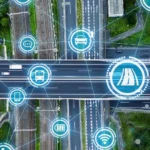Vehicle-to-vehicle (V2V) communication is poised to revolutionize how we think about transportation. In a world where efficiency, safety, and connectivity are paramount, Vehicle-to-vehicle technology emerges as a critical tool in our efforts to create a smarter and more secure automotive landscape. This comprehensive exploration delves into the realm of Vehicle-to-vehicle communication, uncovering its significance, applications across various industries, and its transformative potential for a safer and more connected future of transportation.
The Significance of Vehicle-to-Vehicle Communication
Vehicle-to-vehicle communication represents a groundbreaking shift in the automotive industry’s approach to safety and connectivity. This technology equips vehicles with the ability to communicate with each other, creating a network of interconnected cars, trucks, and even autonomous vehicles. The shift towards V2V communication carries substantial implications, from enhanced road safety to more efficient traffic management.
Enhanced Road Safety
One primary benefit of Vehicle-to-vehicle communication is heightened road safety. By allowing vehicles to exchange critical information such as speed, location, and direction, V2V-equipped vehicles can swiftly detect potential hazards and take preventive actions. This newfound awareness reduces the likelihood of accidents and paves the way for safer roads.
Traffic Efficiency and Congestion Reduction
Vehicle-to-vehicle communication facilitates more efficient traffic management by enabling vehicles to communicate their intended actions with neighboring vehicles, such as lane changes and braking. This real-time coordination leads to smoother traffic flow, reduced congestion, and shorter commute times for all road users.
Emergency Response and Crisis Management
In emergencies, Vehicle-to-vehicle communication allows vehicles to share information about accidents, road closures, or hazardous conditions with nearby vehicles and emergency services. This rapid exchange of information can significantly improve response times and save lives in critical situations.
Techniques in Vehicle-to-Vehicle (V2V) Communication
Vehicle-to-vehicle communication harnesses various techniques and technologies to enable seamless vehicle communication, making our roads safer and more connected.
Dedicated Short-Range Communication (DSRC)
The backbone of vehicle-to-vehicle communication is formed by Dedicated Short-Range Communication, a wireless technology that enables vehicles to exchange information over short distances. DSRC facilitates real-time vehicle communication, ensuring quick response times to potential hazards.
Sensor Fusion and Machine Learning
Sensor fusion and machine learning technologies are integrated into V2V systems to process and interpret the data exchanged between vehicles. These advanced techniques enhance the accuracy of threat detection and decision-making, further improving road safety.
Data Privacy and Security
Ensuring the privacy and security of V2V communication data is paramount. Robust encryption and authentication mechanisms protect sensitive information exchanged between vehicles while maintaining user privacy.
Applications of Vehicle-to-Vehicle (V2V) Communication
Vehicle-to-vehicle communication finds applications across various sectors, each benefiting from its enhanced safety and connectivity.
Autonomous Vehicles
Vehicle-to-vehicle communication is instrumental in the development and deployment of autonomous vehicles. These self-driving cars rely on real-time data from surrounding vehicles to make safe and informed decisions, paving the way for a future of fully autonomous transportation.
Traffic Management and Infrastructure
Vehicle-to-vehicle communication can enhance traffic management systems and infrastructure. Traffic lights, road signs, and infrastructure components can communicate with vehicles to optimize traffic flow and reduce congestion in smart cities.
Fleet Management
Fleet management companies can utilize V2V communication to monitor and optimize the performance and safety of their vehicles. This technology allows for real-time tracking of fleet vehicles and immediate responses to maintenance and safety issues.
Challenges and Ethical Considerations
While Vehicle-to-vehicle communication holds immense promise, it also presents challenges and ethical considerations that necessitate careful consideration.
Data Privacy and Security
Similar to EMS, the collection and exchange of data in V2V communication raise concerns about data privacy and security. Ensuring that personal information remains protected while allowing for effective communication is a crucial ethical consideration.
Standardization and Interoperability
To realize the full potential of V2V communication, standardized protocols and interoperability between vehicle manufacturers must be established. It ensures that all vehicles communicate seamlessly, regardless of make or model.
Cybersecurity Threats
As vehicles become more connected, they become vulnerable to cyberattacks. Safeguarding vehicles against hacking and malicious interference becomes essential to maintain the safety and integrity of V2V communication.
The Future of Vehicle-to-Vehicle (V2V) Communication
Vehicle-to-vehicle communication is poised to assume an even more substantial role in shaping the future of transportation, fostering safety, connectivity, and efficiency.
Vehicle-to-Everything (V2X) Communication
As Vehicle-to-vehicle communication matures, it will evolve into Vehicle-to-Everything (V2X) communication, enabling vehicles to communicate with other vehicles, infrastructure, pedestrians, and cyclists. This comprehensive network will further enhance road safety and traffic management.
Artificial Intelligence and Predictive Analytics
Integrating artificial intelligence and predictive analytics will elevate V2V communication capabilities. This next phase will enable predictive accident avoidance, traffic optimization, and enhanced emergency response, making our roads safer.
Global Adoption and Regulation
Global adoption and regulation are crucial to harness the potential of V2V communication fully. Governments and automotive industry stakeholders must collaborate to establish universal standards and regulations to ensure the safe and effective deployment of V2V technology.
Conclusion
Vehicle-to-vehicle communication is not just a technological innovation; it is a catalyst for a safer, more connected, and more efficient future of transportation. Its significance lies in its capacity to enhance road safety, reduce congestion, and create a more interconnected transportation ecosystem. As V2V communication evolves, ethical considerations, data privacy, and standardized protocols must guide its development and deployment.
The future it envisions is one where transportation is safer, more efficient, and seamlessly connected, ultimately leading us toward a smarter and more secure world of mobility. Vehicle-to-vehicle (V2V) communication is the architect of a future where safety, connectivity, and efficiency drive the evolution of transportation.












